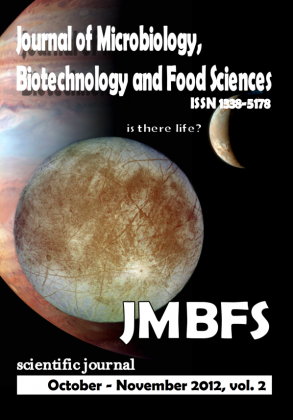BIOLOGICAL REMOVAL OF LEAD BY BACILLUS SP. OBTAINED FROM METAL CONTAMINATED INDUSTRIAL AREA
Keywords:
Industrial area, metal pollution, lead, bacteria, bacillus, bioaccumulationAbstract
In the present study bacterial strains were isolated from soil, sediment and water samples of metal polluted environment. As a result, various 164 heterotrophic bacterial strains were isolated and studied the multiple metal tolerance profile and lead bioaccumulation potentiality. We also analyze the metal contamination of the selected study area. The average abundance order of heavy metal contents in soil, water and sediments were Zn>Cu>Pb>Cd. Zinc concentration ranged from 39.832µg/L to 310.24µg/L in water, 12.81µg/g to 407.53µg/g in soil and 81.06µg/g to 829.54µg/g in sediment; copper concentration from 25.54µg/L to 66.29µg/L in water, 8.22µg/g to 73.11µg/g in soil and 32.28µg/g to 600.61µg/g in sediment; lead concentration from 8.09µg/L to 25.23µg/L in water, 5.31µg/g to 73.11µg/g in soil and 1.02µg/g to 60.14µg/g in sediment and cadmium concentration ranged from 39.832µg/L to 310.24µg/L in water, 12.81µg/g to 407.53µg/g in soil and 81.06µg/g to 829.54µg/g in sediment. Metal resistance studies of the bacterial isolates revealed that out of 164 isolates collected about 45% of the isolates showed very high tolerance (>6000µg/ml) to lead. Tolerance to Cd and Zn were relatively low (<500 µg/ml). Resistance to Ni and Cr were in between 1000µg/ml - 1500µg/ml. A total of 18 bacterial genera were recorded from the study area; ten genera from soil and 11 from water, while only 5 bacterial genera were recorded from sediment samples. Bioaccumulation studies revealed that with increase in time, the biomass of the selected bacterial isolates increased. Correspondingly, with increase in biomass, the heavy metal bioaccumulation was also increased. In lead removal studies, around 50% of the lead in the experimental flasks was reduced by Bacillus sp. In control flask, only 5% metal reduction occurs. The obtained results showed that the selected Bacillus sp. is good bioaccumulation medium for lead ions.Downloads
Download data is not yet available.
Downloads
Published
2012-10-01
How to Cite
Varghese, R., M. P., K., Babu V., A., & Mohamed Hatha, A. (2012). BIOLOGICAL REMOVAL OF LEAD BY BACILLUS SP. OBTAINED FROM METAL CONTAMINATED INDUSTRIAL AREA. Journal of Microbiology, Biotechnology and Food Sciences, 2(2), 756–770. Retrieved from https://office2.jmbfs.org/index.php/JMBFS/article/view/7179
Issue
Section
Microbiology
License
Copyright (c) 2012 Rinoy Varghese, Krishna M. P., Arun Babu V., A. Mohamed Hatha

This work is licensed under a Creative Commons Attribution 4.0 International License.
All papers published in the Journal of Microbiology, Biotechnology and Food Sciences are published under a CC-BY licence (CC-BY 4.0). Published materials can be shared (copy and redistribute the material in any medium or format) and adapted (remix, transform, and build upon the material for any purpose, even commercially) with specifying the author(s).

